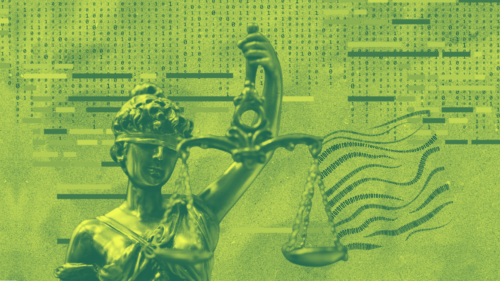In 1992, Portland District Attorney Michael Schrunk asked then Assistant District Attorney Mike Kuykendall to help launch a community prosecution program, one of the first in the country. Later, he directed the Community Prosecution Program at the American Prosecutors Research Institute in Virginia for several years before returning to Portland. At the time of this interview, he was Vice President of Central City/Downtown Services for the Portland Business Alliance. Here he speaks with the Center for Court Innovation’s Robert V. Wolf about his work.
Community prosecution as it’s practiced around the country takes many forms, which makes it hard to define. When you talk to other people about community prosecution, how do you describe it?
It’s a grassroots effort by the local elected prosecutor to get their assistant prosecutors, citizens, local government resources, police and other stakeholders in the community involved in identifying low-level criminal offenses and neighborhood livability issues and engaging in long-term solutions to those offenses. The emphasis is not on arrest and prosecution, but on learning new ways to prevent crime from occurring… That’s the vision the federal government has embraced as have the majority of jurisdictions now practicing community prosecution…
We do on occasion see prosecutors who claim they’re embracing community prosecution by putting lawyers in the field to do just drug prosecutions or other traditional prosecution, but that’s not really community prosecution because that’s not involving the community in solving problems that affect their neighborhood.
What were some of your accomplishments as a community prosecutor in Portland?
Probably the biggest accomplishment was developing no-buy, citizen-driven search warrants. We used to have low-level drug-dealing houses up in North Portland. They’d have 40 or 50 buys a day for smaller quantities of marijuana and cocaine. These were lower-level quantities but it really affected the neighborhood because they had all these drug users coming in and out all day and night. Because it wasn’t that big of an operation—they were dealing in grams, not kilos—the Drugs and Vice Divisions weren’t involved… so basically they could deal drugs with impunity…
Ordinarily, to grant a search warrant, our local judges like to see at least three undercover buys, but we developed another way to obtain a search warrant. I trained citizens on how to make complete and accurate observations, which the police could put in an affidavit and present to a judge… This is how it worked: I had neighbors keep log sheets with the date and time of every visit to the house. They also wrote down the plate number and a description of what happened. Most of the descriptions went like this: Car pulls up, someone runs out, pulls out money, gets something in return for his money and jumps back in the car. It wasn’t always money, though. People showed up with chainsaws, bicycles, televisions, computers, etcetera… Over the course of several months we were able to put together an affidavit that was sufficient to put before a judge requesting a search warrant; the police then went in, based entirely on citizens’ observations…
The first time the police executed a no-buy citizen-driven search warrant they recovered a little bit over an ounce of marijuana but all of it was bagged up for sale. There were also about $500 in small bills, and scales for weighing. The police arrested the husband and wife team, and confiscated all the stolen property as well. They ended up pleading guilty to delivery of drugs, were put on probation with extensive conditions, including drug treatment and a ban on visitors to their home. The neighbors helped supervise the terms of probation by reporting any violations… Eventually the couple moved away to avoid the scrutiny, but we alerted the district police officer in their new neighborhood so that the problem wouldn’t begin anew. Had it not been for a community prosecutor working with citizens to create a new legal solution, there’s no doubt in my mind that that couple would still be dealing.
Is community prosecution appropriate for low-level and quality-of-life crime only? What about violent crime?
I think community prosecution is primarily relevant for low-level crime and what are called crimes of livability. It’s virtually impossible to predict when a murder or a rape or a robbery will occur, so community prosecution isn’t really equipped to deal with those kinds of crimes. Community prosecution deals with low-level crime because it tends to happen in the same areas again and again—prostitution, drug dealing, illegal dumping, breaking into vehicles and stealing things. Those are things we can fairly well predict where they’ll occur and when… The reason we can’t stop them is because the sanctions available in traditional courtroom settings are often so minimal they don’t encourage people to discontinue their behavior. If you arrest someone for murder and convict them, you can keep them from murdering at least because they are in custody, but if they’re picked up for prostitution and only get a $200 fine and unsupervised probation, they’re often back walking the street in short order.
Community prosecution is an attempt to change the environment where those kinds of crimes occur. Sometimes you can do that simply by changing the lighting, changing the traffic pattern, organizing a block-watch effort; or bringing out at sentencing a victims impact statement so the judge will be aware of the impact of that conduct on the community and hopefully issue a more meaningful sentence.
How do you convince front-line prosecutors to participate enthusiastically in community prosecution efforts?
That’s a good question and one that needs to be addressed any time a community prosecution program is being considered. Typically, most assistant district attorneys are busy in courtrooms eight hours a day dealing with judges and lots of cases, and they look at community prosecutors going to night meetings and setting up task forces and see work they’re not particularly interested in doing… But as an office moves deeper and deeper into community prosecution, everyone begins to see the benefits of the program to the office. It reduces caseloads, improves relations with the community and police, and often improves the actual cases in the system by building cooperation and confidence between the players.
I believe it’s a good practice to reward community prosecutors who have done a good job—that leaves an impression on the rest of the office that community prosecution really matters to the elected prosecutor. You don’t want the community prosecutors to fall in salary or office status behind their peers who didn’t go out in the community. One way to do this is for the elected prosecutor to ask their community prosecutors where they want to go when they are ready for rotation back to a trial unit. Another way is to provide additional compensation and comp time to those who agree to work in the community.
Community prosecution, like many community justice initiatives, often relies on anecdotal evidence to substantiate its effectiveness. But many funders, and even the public, want to see more tangible evidence of success before they support it. What sort of research and evaluation is being done to measure whether or not community prosecution is effective?
The hard thing, like so many programs in criminal justice, is that people want to know, ‘Did crime go down, and if so, was it because of this program or that program?’ And that’s one of the most difficult things we deal with. The mark of a successful community prosecution program isn’t necessarily a drop in crime numbers; the numbers might actually increase because citizens are more involved, and reporting more crimes… There are a lot of other measures of success; the most important is the overall feeling of safety and security in the community and you can measure that easily by surveying the community before and after your program has been implemented. You can also quantify the number of meetings your prosecutors attended, the number of citizens involved in crime prevention committees, etcetera, to determine if your office has met its goal of more community input into public safety concerns.
Collaboration—with other public and community-based agencies—seems to be part of the definition of community prosecution. What makes a prosecutor a good collaborator? What resources can prosecutors bring to the table to encourage collaboration?
A lot of really good trial attorneys are guard-dog types. They tear into a case, and drive and push and never take no for an answer; those people typically make good courtroom prosecutors, but don’t always make good community prosecutors; good community prosecutors need to be able to listen, to not necessarily lead from the front but lead from behind. They also need to have good people skills and be willing to go the extra mile, even if it means going to community meetings until 10 at night. They need to be real problem-solvers who are self motivated and don’t require a lot of supervision. They need to be creative thinkers capable of utilizing the law, both criminal and civil, to the communities’ advantage.
Selecting the right person to serve as a community prosecutor can be a challenge. Elected officials are sometimes very reluctant to let line prosecutors go out and speak publicly about the efforts of the prosecutor’s office; it just makes them nervous to have an assistant district attorney speak on their behalf. The elected prosecutor wants to speak to the public and media about what he or she is doing. It takes a special kind of prosecutor to have trust in a deputy to do and say the right thing, often without direct supervision or much input from the office.

